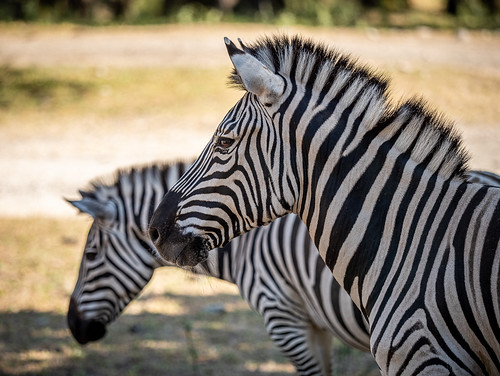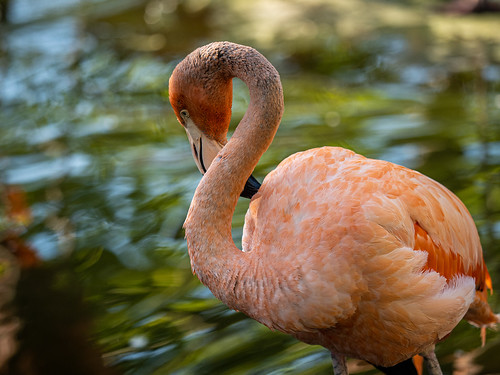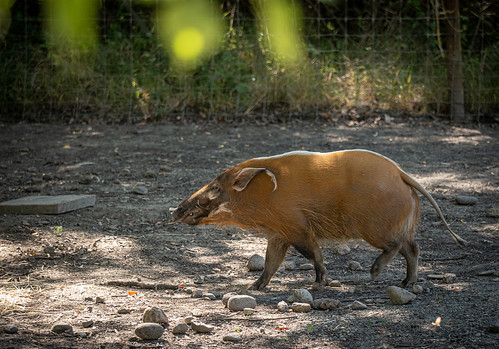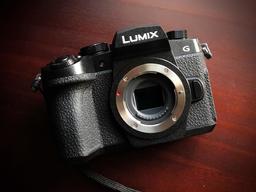As the saying goes, "It was hot. Africa hot."
I wasn't on the subcontinent with a Panasonic G95 in hand, but rather at Safari West during a heat wave that had stifled Northern California.
I wanted to see how Panasonic's latest MFT camera body would hold up in adverse conditions while working with my Olympus M.Zuiko Digital ED 40-150mm f/2.8 PRO lens. The G95 is billed as an excellent travel camera. And for good reason. It's light in weight, relatively compact in size, and it supports a variety of still photography and video features. The oversized handgrip (that's very comfortable) seemed like a good match for the longer telephoto lens. And the 20 MP sensor combined with 5-axis sensor stabilization felt like a robust tandem for this assignment.
 "White Rhino" - 1/500th at f/2.8, ISO 200, 150mm - Photo by Derrick Story.
"White Rhino" - 1/500th at f/2.8, ISO 200, 150mm - Photo by Derrick Story.
The first thing that I had to figure out was the focusing array. After some fiddling around and experimentation, I settled on the Custom Multi pattern with the more compact AF area. This provided me with a little margin for error in the center part of the frame, but limited the focus point choices. There are 3 sizes to choose from with the pattern, I went with the middle option. In the future, I think I'll go with the smallest to provide me with the most control. That being said, most of my images were crisp with very few focusing misses.
 "Zebra Pair" - 1/400th at f/2.8, ISO 200, 150mm - Photo by Derrick Story.
"Zebra Pair" - 1/400th at f/2.8, ISO 200, 150mm - Photo by Derrick Story.
The next adjustment that I made was to reconfigure the dial around the shutter button for exposure compensation. I have all of my Olympus cameras set up this way, and it's one of my favorite features of mirrorless photography. In the menu, it's under custom wrench > Operation > Dial Set. This allowed me to quickly adjust exposure without missing the shot.
 "Flamingo" - 1/400th at f/2.8, ISO 200, 150mm - Photo by Derrick Story.
"Flamingo" - 1/400th at f/2.8, ISO 200, 150mm - Photo by Derrick Story.
In the field, focusing responsiveness with the Olympus 40-150mm lens was good. The manual focus override worked well when I needed it, complete with focusing assist. The exposures were quite accurate and the color was pleasing.
I did switch to Silent Mode (via the menu) so as not to annoy my comrades with focus confirmation beeps. At one point, my brother-in-law turned to me and asked, "Are you taking any pictures?" He hadn't heard a thing. That was exactly what I wanted.
 "Big Horns" - 1/800th at f/3.2, ISO 200, 150mm - Photo by Derrick Story.
"Big Horns" - 1/800th at f/3.2, ISO 200, 150mm - Photo by Derrick Story.
I captured in RAW+Jpeg so I could evaluate both formats. I processed the RAWs in Lightroom 2.3, which did a good job of decoding the RW2 files. The Jpegs looked quite good. But when compared side-by-side with the unedited RAW files, I still preferred the look of the RW2 pictures, even without adjustments.
 "Wild Pig" - 1/320th at f/3.2, ISO 400, 150mm - Photo by Derrick Story.
"Wild Pig" - 1/320th at f/3.2, ISO 400, 150mm - Photo by Derrick Story.
The camera did heat up, but it didn't seem to adversely affect image quality. Performance was good. The battery hung in there for the entire shoot. And the images are pleasing.
I would say that the Panasonic Lumix G95 did itself proud under these challenging conditions. Next stop with the camera is Santa Barbara. Stay tuned.
You can share your thoughts at the TDS Facebook page, where I'll post this story for discussion.












